Ailish Lalo – What was the VOC? The Dutch East India Company explained
22 augustus 2021Businessplan, Home, Locatie, Media, Ridderboek, Video0
VOC Ship (foto AJEL | Pixabay)
What was the VOC? The Dutch East India Company explained
The VOC (in Dutch Vereenigde Oostindische Compagnie) is a crucial part of Dutch History. If you’ve been living in The Netherlands for a couple of months, or you have some knowledge of this flat country, you’ll have heard of the VOC, or the Dutch East India Company. But a lot of the time, it’s not entirely clear what this Company was, what it did, and whether we should be Proud or Ashamed of it.
In this article, we’re taking a deep dive into the World of the VOC. We’re going to tell you when it started, what it did, how it ended, and what that means for The Netherlands today. Over two hundred years, the VOC brought The Netherlands international Power and Wealth, while Exploiting Local Populations, Creating Colonies, and Trading in Human Beings.
The Story of the VOC is complicated, and this is not an exhaustive History of it (if you want that, buy a Book or 10 more). What this Article offers is a Primer on the VOC: a less than Casual Introduction. Enjoy!
How did the VOC begin?
The VOC was established in 1602 as a chartered Company, whose goal was to trade with Mughal India, where the Majority of Europe’s Cotton and Silk in this Period originated from. Quickly, the Dutch Government gave it a 21 year Monopoly on the Spice Trade with South Asian Countries, and the Company took off from there.
Sounds nice and simple, but the VOC soon became the very first Conglomerate Company which is a fancy way of saying they did a bunch of different things (like Shipbuilding, Slave Trading, and Colonisation) under the same Company Name.
What on Earth was the VOC?
In the early 1600s, the VOC became the first Company to be listed on the Stock Exchange. This, along with its Worldwide Reach and Transnational Employees, is among the reasons the VOC is viewed as a Forerunner of modern day Multinational Corporations.
The VOC had Powers that a Corporation today would hopefully never have: it was given the Power to Wage War, To Take and Execute Prisoners, To Coin Money, To Negotiate Treaties, and To Establish Colonies. It did all of this. As much as modern day Corporations like Google and Shell have way too much power, the VOC was a whole different level.
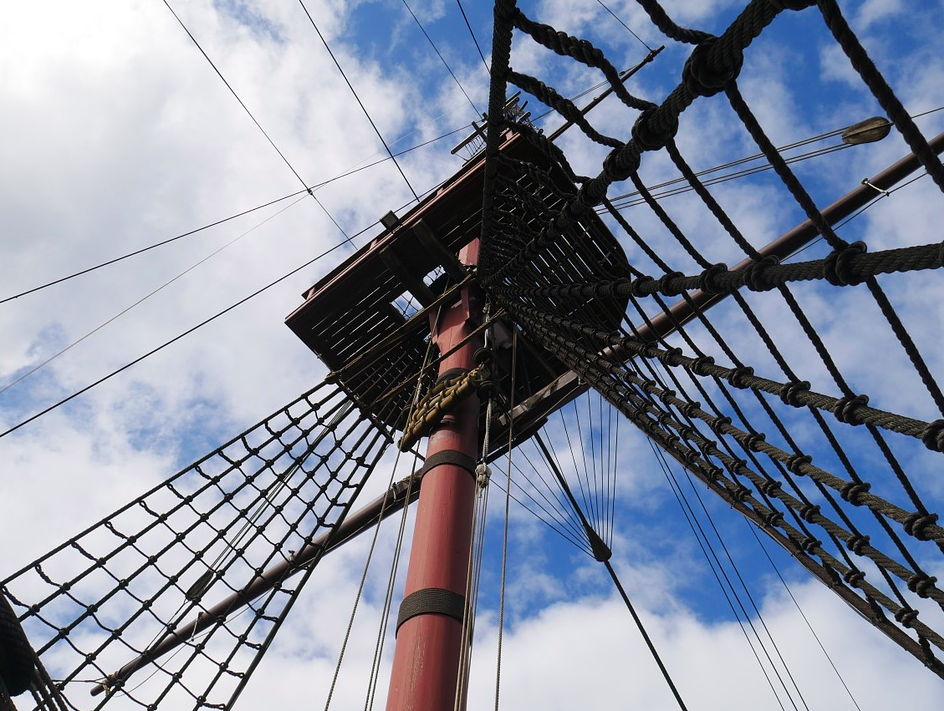
The VOC was a Forerunner of Global Companies we see today (foto FrankMagdelyns1 | Pixabay)
Where did the Dutch East India Company operate?
As we have already mentioned, the VOC started off operating in India, and in South Asia in general. Over the next century, it expanded its Operations to Mauritius and South Africa, as well as Indonesia, India, Taiwan, Japan, Malaysia, Thailand and Vietnam. Not all of these Locations were the Sites of Permanent Settlements or even Permanent Trading Posts, but listing them all here gives us a sense of how massive this Company was.
What was Happening in The Netherlands when the VOC was In Operation?
The VOC was ostensibly founded after a Dutch Ship returned from South East Asia filled with very Profitable Spices in 1596. But when we’re considering the VOC as an Entity, we also need to look at what was surrounding it at the time. What was going on in The Netherlands that would have made this Massive Company worth investing in?
Put simply, The Netherlands was Under Threat. It had just declared it’s Independence from Spain in 1581, forming the Dutch Republic. Quite an Ambitious Move, considering that the Spanish had the Force of Half of Europe behind them, considering how much of the Continent they controlled at the time.
Given this Vulnerability, you can see the Advantages of Drawing Wealth from Outside the tiny Dutch Republic, and using it to shore up the Newly Established Country against Foreign Control (while, of course, controlling other Countries – but we’re not talking about Morality or even Ideological Consistency here).
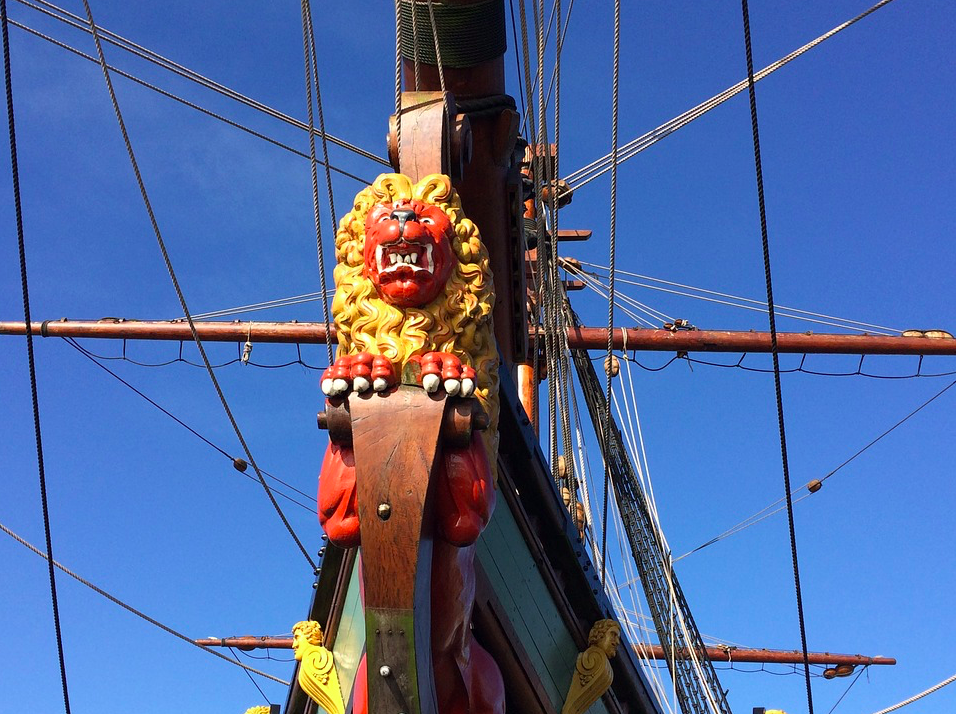
The VOC was also an instrument of War (foto AJEL | Pixabay)
The VOC creates the Shareholding System (and also Global Capitalism)
The VOC is considered the First Modern Multinational Company, and first made use of many of the Features we associate with Modern Corporations: think Shareholders, Corporate Identity, Legal Personhood, Separation of Ownership and Management, and so on. This Collection of Innovations meant that the VOC could mobilise Wealth in a way that only Monarchies could before, giving it the Sort of Unprecedented Power we see Massive Companies like Google and Shell making use of today.
When it comes to the way it acquired this Wealth, the VOC was also Innovative. It basically formed Amsterdam as the Financial Capital of the Contemporary World. By allowing Members of the Public to invest in the Company (rather than in things the Company was doing, as had been the Previous Methodology for Gathering Money).
The Dutch East India Company and War
A Massive Company like the VOC naturally attracted Attention – and because of its Dominance in International Trade, that Attention was mainly Negative. It got into Conflict with the British East India Company, for obvious Reasons: they were both going for the same Thing. Because of the Weird Space the VOC occupied – Part Company, Part State – its Trade Objectives often Aligned with Military Objectives. For example in 1667, when the Treaty of Breda was signed, ending the War with Britain, the VOC acquired Sole Control over the Nutmeg (in Dutch Nootmuskaat )Trade.
Wars also played a Role in the Colonisation of Different Areas: in South Africa, a Prolonged, Low Level Conflict with the Local Khoikhoi Population eventually resulted in Khoikhoi Society breaking down, and the Expansion of European Settlements in the Area. In Indonesia, there were Three Wars between the Dutch and the Javanese at times of Succession, as the VOC tried To Increase their Influence in the Area by placing their People at the Top. In 1641, through the Battle of Malacca, the VOC took Control of Malacca from the Portuguese, thus increasing their Domination of the Area.
The VOC and Colonisation
One of the Problems with how the VOC is talked about in The Netherlands is that People aren’t really sure what it was. A Business? A Force for Colonisation? A Slave Trading Enterprise? A Force for Bureaucracy in the World? The Truth is that it was All These Things, and more.
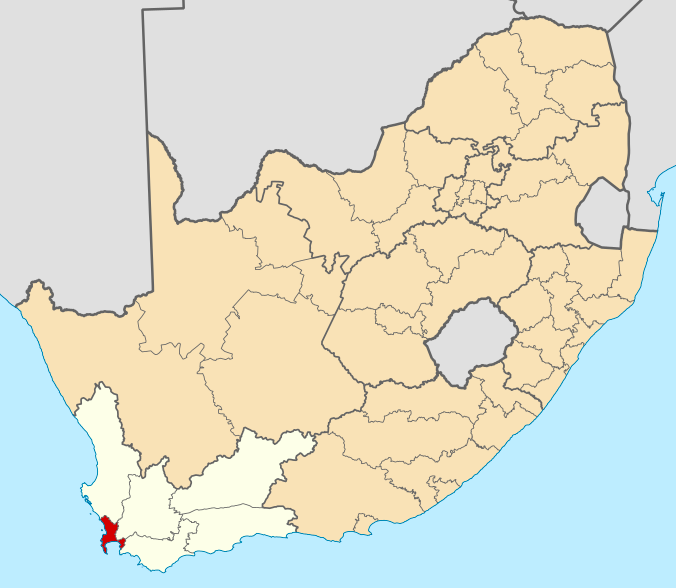
The VOC controlled the Cape (foto Htonl | Wikimedia Commons)
How the VOC Colonised South Africa
In the Cape, Colonisation took place over almost two Centuries. At first, Dutch Settlers in South Africa were Massively Outnumbered by the Local Khoikhoi Population, for context, there were 200 Europeans and about 20,000 Khoikhoi. At first, this Minimal Presence was accepted by the Local Population. The Settlement at the Cape acted much more as a Trading Hub than a Colony. Slowly, though, the VOC’s Plans for Expansion became apparent, heir Transportation of Slaves (more on this below!) to the Colony was just one Symptom of their Plans to Settle a large Colony of Europeans there.
In the 1660’s Conflicts broke out between the Khoikhoi and the Dutch, and the Dutch Burghers expanded their farms outwards. But the Khoikhoi were Truly Defeated by the Arrival of Smallpox on the Shores of South Africa – a Familiar Story to anyone well versed in the History of Colonisation. In 1713 the Disease arrived, and it killed off 90% of the Khoikhoi. By the End of the Eighteenth Century, Khoikhoi Society had Disintegrated, and there were 20,000 Europeans living in the Cape. Soon after, in 1795, the Territory was Ceded to the British, when The Netherlands was Invaded during the Napoleonic Wars. At the End of the Wars, the Cape Colony was Formally Handed Over to the British, whose Colony it remained a Part of until 1931.
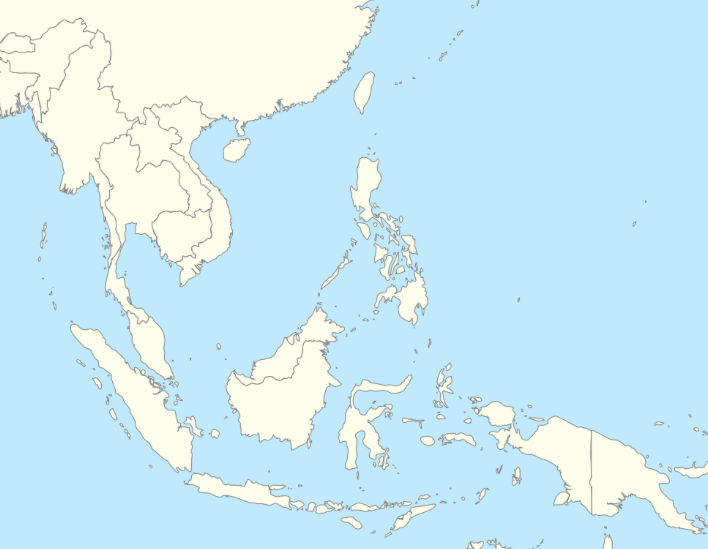
The Dutch East Indies were crucial for the VOC (foto Hariboneagle927 | Wikimedia Commons)
The Dutch East Indies: what did the VOC do?
Colonisation in the Dutch East Indies is a really intriguing Topic, because when you boil it down, “True” Colonisation of the Area only began once the VOC failed Financially and was Nationalised in an attempt to save it. This meant that Territories that had belonged to the VOC became part of the Dutch Republic’s Territory. This doesn’t mean, though, that what we intuitively consider Colonisation wasn’t taking place before this Nationalisation Process, though.
For example, in Jakarta, then known as Batavia by the Dutch, the VOC began to grow Cash Crops there in the early Seventeenth Century. We can see this as a clear Move from trading in the Spices they had a Monopoly on to growing Crops they could also make a Profit on from Land that was not theirs.
To safeguard these Crops, the VOC also took over the Surrounding Territory, increasing their Power in the Area. By the late Seventeenth Century, the VOC had become deeply embroiled in the Internal Politics of Jakarta, despite their Initial Intentions to not get involved in Domestic Affairs. They encouraged Divisions between the Different Kingdoms in the Indonesian Archipelago (again, you’ve undoubtedly heard of the Phrase ‘Divide and Conquer’ before), and took part in two Wars against the Kings of Mataram and Banten.
After the VOC collapsed in 1800 (more on this later) the VOC’s Trading Posts and Colonies in the Indonesian Archipelago became Nationalised as the Dutch East Indies.
The Dutch East India Company and Slavery
The VOC also took part in Slavery and Slave Trading during its two hundred years of Activity. From its Inception, it exploited Workers in the East Indies, sometimes engaging in Slavery. However, its Use of Slaves really picked up when it took Control of the Cape in South Africa.
After realising that the Backbreaking Work of establishing a Settlement there would need to be done by Slaves, the VOC deliberated over enslaving the Local Khoikhoi Population, which vastly Outnumbered them. When they determined that if they annoyed this Group they could easily be kicked out, they decided instead on importing Slaves from Mauritius and the Dutch East Indies.
VOC Slavery in the Cape
For much of the Seventeenth Century, the Number of Slaves in the Cape remained Low – about 1.000 at a time. Slaves mostly were taken from Ceylon, Madagascar and Malaya. Because the Population was mostly Male, it had to be constantly renewed with new slaves. In the eighteenth century, this number jumped to about 17,000 as the International Slave Trade increased. Most of the Slaves who ended up in the Cape came from either East Africa or the VOC’s Territories in the Dutch East Indies.
VOC Slavery in the Dutch East Indies
Slavery was also part of how the VOC operated in the Dutch East Indies, but the Story there is more complicated. In their Operations in South Africa, the VOC specifically transported Slaves from other Regions to exploit while building their Colony. In Asia, the VOC mainly used Local Slaves or at least Slaves from the Region. Moreover, some of these Slaves would have been already Enslaved by their Local Community. But the Presence of the VOC heightened the Demand for Slave Labour, so just because Slave Labour was Part of Life in some Asian Countries before their Presence, the VOC is Not Absolved of Guilt.
Business Casual – When The Dutch Ruled The World: Rise and Fall of the Dutch East India Company
How the Dutch East India Company ended
Given that the VOC was so big, you would imagine that its End would have been quite Catastrophic to the Status of The Netherlands Worldwide. You might also be wondering what exactly happened to this Company to make it Collapse in 1800 – after all, controlling a Lot of the Spice Trade gives a Company a Fairly Hefty Advantage.
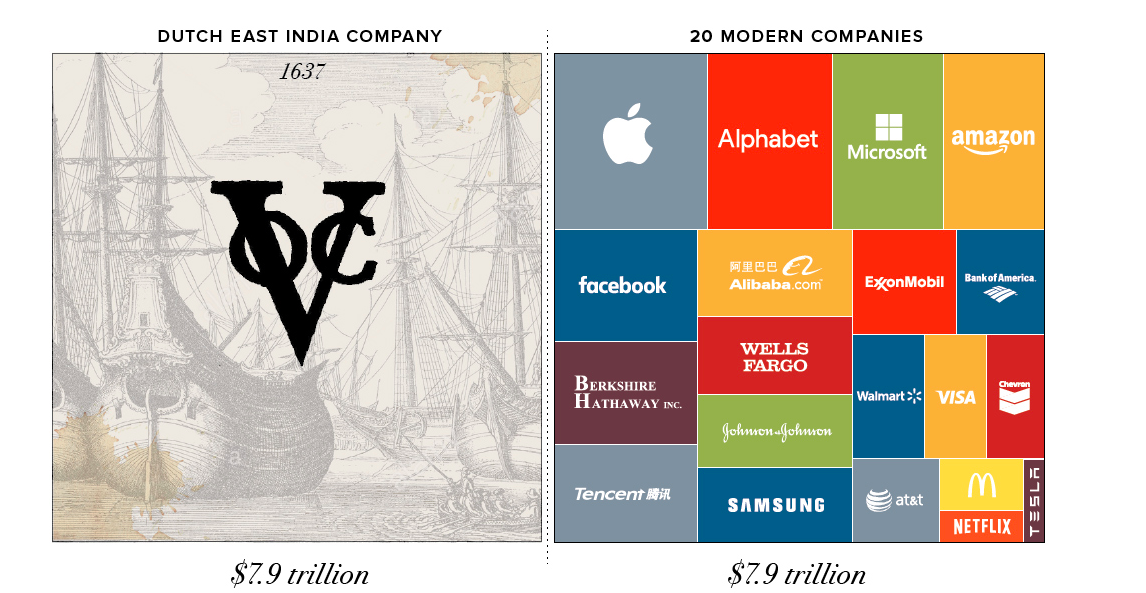
The VOC’s Wealth (adjusted for Inflation) was enormous (foto Visual Capitalist)
Methodology Problems in the VOC
There were a Bunch of Problems with how the VOC operated in Asia – a Couple of which had been Advantageous to it in the Early Days. However, as time progressed into the Eighteenth Century, Cracks began to show in the VOC’s Commercial Prowess.
One Problem was that it brought all the Goods it traded between Asia and Europe first to its Trading Posts in Asia to be Sorted or Stored. In contrast, the English East India Company would trade directly between Europe and, for example, China. This meant that other Companies were making Faster Journeys and providing Fresher Goods- never a good thing.
This had, of course, been an Advantage for the VOC in the Beginning of its Trading Journey, because they had had a Better Understanding of Asia Commercially in a Centralised Place than their Competitors did.
The Dutch East India Company Staff
Another Problem was its Staff. The VOC was, frankly put, a Terrible Employer (like many Modern Day Multinational Companies). It offered Low Wages and forbade its Staff to engage in Private Trading, meaning they had No Opportunity to Increase their Wages Legally.
Of course, many of them did: the VOC suffered Huge Amounts of Corruption among its Employees, mostly because making the Journey to Asia wouldn’t have been Financially Worth it for them without this Extra Income. And the Financial Bounty had to be good, because we’re talking about a Fairly Dangerous Time for Travelling the World. War, Different Illnesses from different Parts of the World, Malnutrition, and some Nice Venereal Diseases killed Plenty of VOC Staff.
The VOC did not understand Maths
Finally, there was what could be termed a Mathematical Problem: the VOC paid its Shareholders Dividends in Excess of the Profits they made from 1730 onwards. Let’s just say that again: the VOC decided to pay its Shareholders more than it made. I am not a Businessperson, but this is unequivocally a Bad Idea.
What this meant in Practice was that the VOC did not have enough Liquidity to finance its Operations for the last Seventy Years it was Active – it relied on Short Terms Loans to do so. Eventually, things would have to change.
The VOC and War: The End
And they did, but not in the way the VOC might have hoped. In 1780, the Fourth Anglo Dutch War began, and half of the VOC’s Fleet was Destroyed. Furthermore, the Control of its Asian Trading Posts was Massively Weakened. The VOC was a Complete Financial Mess after the War, as indeed was the Dutch Republic, which didn’t exist for almost Thirty Years after the Anglo Dutch War Ended.
From 1799, the VOC’s Contract was not renewed, and it ceased to exist. In 1814, after the Congress of Vienna, some of The Netherlands’ Territories in Asia were returned to it, and these became Colonies of the Netherlands, pure and simple.
Reception in Dutch Society Now
As a Historian, I firmly believe that it’s wrong to ignore how things in the Past have shaped the Present Day. The VOC was a Huge Part of how the Dutch Republic functioned for almost two hundred years. Today, it affects the National Image of The Netherlands and the People who make this Country up. It also affects what we have in our Museums, and what lines the National Coffers.
The “VOC Mentality”
As we move into an Era where Colonialism is (happily) viewed as a Negative Thing, the image of the VOC in the Netherlands has become complicated and fraught with Conflict. In 2006, the then Prime Minister Jan Pieter Balkenende coined the term “VOC Mentality” in a Speech about Dutch Commercial Thinking and Innovation. A lot of People were Offended by this Association of the VOC with Purely Positive Characteristics, without acknowledging the Harm it caused over its two Centuries of Operation.
Dutch Colonialism in Society Today
In general, The Netherlands’ Colonial History has received a Lot of Attention over the last Decade. From the Annual Zwarte Piet Debates to the Mauritshuis’ Decision to take down the Bust of its Colonial Founder, the Country is slowly (very slowly) coming to terms with its Past. Museums have begun the Process of returning Stolen Objects to their Countries of Origin. Universities have begun the Complicated Process of Decolonising their Curricula, and the Amsterdam Museum has made the Decision to drop the phrase “Golden Age” from its Permanent Exhibition Texts. The Case of the Relatives of Colonial Victims in Indonesia will be heard in Court.
The Dutch Golden Age: Fool’s Gold
Part of the Reason this Process of Reckoning is taking so long is that for a lot of Dutch People, the VOC’s Trading Prowess coincided, and in part caused, the “Golden Age” of the Dutch Republic to occur. This was a time when a Very Small Country held Superpower Status over much of the World and fended off its much larger and Better Equipped Enemies in Spain through controlling other Parts of the World. In a World where International Power is still Glamorised and Coveted, it is understandable (if not excusable) that a lot of People want to Nostalgically hold on to the Memory of the VOC.
List for Further Reading
- Gert Oostindie – Dutch Colonialism, Migration and Cultural Heritage –
- John Hunt – Dutch South Africa: Early Settlers at the Cape
- Leonard Blussé – Four hundred years on: the public commemoration of the founding of the VOC in 2002
- Henk den Heijer et al – The VOC and the exchange
- Hendrik Niemeijer – Batavia: Een koloniale samenleving in de 17de eeuw
Editor’s Note
This Article was originally published on December 2019, and was fully updated May 2021 for your Reading Pleasure.
Dutcch Review, May 7, 2021
https://dutchreview.com/culture/history/voc-dutch-east-india-company-explained/
Meer informatie
https://robscholtemuseum.nl/?s=Ailish+Lalo
https://robscholtemuseum.nl/?s=Dutch+Republic
https://robscholtemuseum.nl/?s=Independence+from+Spain
https://robscholtemuseum.nl/?s=VOC
https://robscholtemuseum.nl/?s=East+India+Company
https://robscholtemuseum.nl/?s=Dutch+East+India+Company
https://robscholtemuseum.nl/?s=British+East+India+Company
https://robscholtemuseum.nl/?s=Vereenigde+Oostindische+Compagnie
https://robscholtemuseum.nl/?s=Verenigde+Oost+Indische+Compagnie
https://robscholtemuseum.nl/?s=Trade+Monopoly
https://robscholtemuseum.nl/?s=Treaty+of+Breda
https://robscholtemuseum.nl/?s=Nutmeg
https://robscholtemuseum.nl/?s=Nootmuskaat
https://robscholtemuseum.nl/?s=Colonialism
https://robscholtemuseum.nl/?s=Colonisation
https://robscholtemuseum.nl/?s=Foreign+Control
https://robscholtemuseum.nl/?s=Multinational
https://robscholtemuseum.nl/?s=Shareholding+System
https://robscholtemuseum.nl/?s=Corporate+Identity
https://robscholtemuseum.nl/?s=Separation+of+Ownership+and+Management
https://robscholtemuseum.nl/?s=Google
https://robscholtemuseum.nl/?s=Shell
https://robscholtemuseum.nl/?s=Khoikhoi
https://robscholtemuseum.nl/?s=Malacca
https://robscholtemuseum.nl/?s=Indonesia
https://robscholtemuseum.nl/?s=South+Africa
https://robscholtemuseum.nl/?s=The+Netherlands


Plaats een reactie